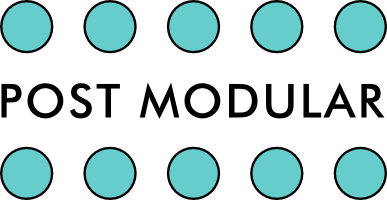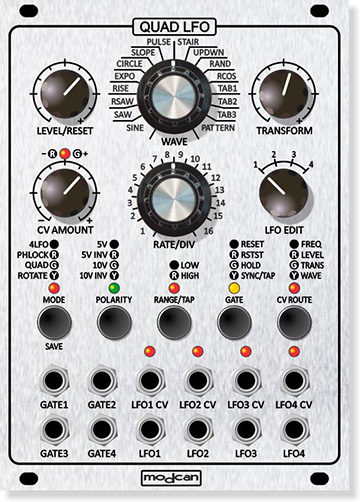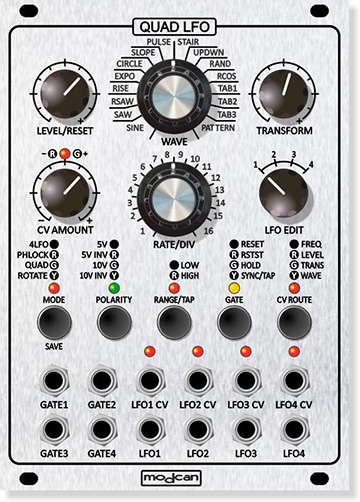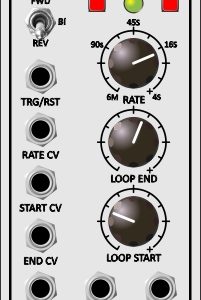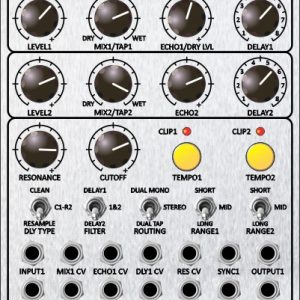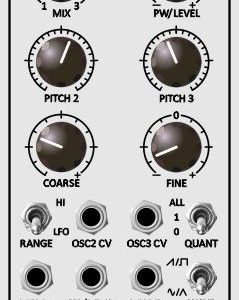Description
The Quad LFO is a versatile and powerful source of modulation wavesforms that will extend the modular LFO well beyond simple vibrato. The Quad LFO has 16 wave types to choose from including various random waves and morphing wave sets which are actually 32 waves with smooth morph transition with the potential for thousands of different shapes. Each of the regular waves employs some form of real-time waveform transformation. For example the Sine wave can smoothly transform into a triangle wave, The stair case wave can change the number of steps on the fly, the Random wave has built in slew for smoothing, The pulse wave has variable width (PWM) etc. Please take a look at the animated gifs to see all the possible wave transforms possible.
Each of the 4 LFOs can function independently with separate control over frequency , amplitude, waveform selection, waveform transform, and CV routing. Each LFO becomes “live” for editing when selected using the 4 way rotary switch. All knob and switch settings are saved in EEPROM for later power up.
There are over 200 possible switch combinations per LFO providing a huge degree of flexibility when using all 4 LFOs. Each LFO has an accompanying GATE and CV input. The Gate is used for RESET and sync functions while the CV input can be routed to any or all of the frequency , amplitude, waveform selection and waveform transform functions for modulation of parameters.
While each LFO can operate independently there are also modes which extend the module in ways that make it truly unique.
QUADRATURE MODE converts the Quad LFO to a single LFO but with quadrature outputs spaced 90 degrees apart. This feature in itself is not radically new but the ability to have quadrature waveforms OTHER than sine shape is. Here we have all the waves available in quadrature including random and morphing waves for advanced quad panning or barberpole type effects.
PHASE LOCK mode in another unique feature of the Quad LFO which synchronizes the phase of all 4 LFOs waveforms but allows the frequency to be a division of the master LFO 1. This is a great way to generate complex drum sequence rhythms using the PATTERN wave.
ROTATE MODE functions like an electronic switch with a gate/clock applied at GATE1 the 4 LFO outputs rotate 1 step to the right wrapping 4 to 1 with each new pulse. Each LFO is independent in its settings only the outputs change order. Great for creating unusual or unpredictable modulation shapes.
The GATE section has a number of unique features for an LFO.
RESET mode does what it says. When a gate pulse is received at the gate input jack the LFO waveform resets to zero like a hard sync function on a VCO. RSTST or Reset Start mode performs similarly to RESET mode with the added bonus of allowing the user to set the waveform start position using the Reset Knob or CV. HOLD mode freezes the LFO when the gate input is high. SYNC/TAP mode uses the gate pulse period to set the frequency of the LFO. This is a great feature for synchronizing the LFO to sequencers etc as an auxiliary event generator and for creating unique CV patterns. The TAP button can also be used instead of the gate jack to manually set the LFO frequency. In sync mode the frequency can also be set to division of the input gate/clock from 1-16 including odd number divisions like 3,5, etc.
Quad LFO features:
- 4 Independent LFOs
- Low and high frequency ranges. Low range is .003Hz-51Hz
- High range is 16HZ-1.6kHz and can be used for audio
- Real-time CV control of Frequency, Amplitude, Wave Morph and wave selection
- Output choice of 0 to +5V, +/-5V and inverted version of both
- 16 bit 48kHz sample rate means super smooth waves with no quantization stepping.
- Memory storage of all settings between power cycles
- 100s of button combinations for massive flexibility
- Unique waveforms like cosine random and stair case waves
- Smooth wave morphing in TABs 1-3
- All waves employ some form of transformation wave shaping
- Uses a paltry 40mA of current on the +12 rail and 10mA on the -12V rail
- 18HP wide shallow depth approx 1″
Firmware by Bruce Duncan
Specs:
Sample rate: 48kHz @ 16bit
Output: 0 to +5V or +/-5V
CV control jack range: +/-5V
Gate input range: 2.5-10V
Current: 40mA@+12V, 10mA@-12V
